|
Size: 13854
Comment:
|
Size: 16934
Comment:
|
| Deletions are marked like this. | Additions are marked like this. |
| Line 2: | Line 2: |
| '''[TUTORIAL UNDER DEVELOPMENT: NOT READY FOR PUBLIC USE]''' | '''[TUTORIAL UNDER REVISION]''' |
| Line 4: | Line 4: |
| ''Authors: Takfarinas, Juan, François ...Sophie, Johannes, Maria, Christian, Carsten, John, Richard ? '' | ''Authors: [[https://neuroimage.usc.edu/brainstorm/AboutUs/tmedani|Takfarinas Medani]], Juan Garcia-Prieto, Francois Tadel, Sophie Schrader, Anand Joshi, Christian Engwer, Carsten Wolters, John Mosher and Richard Leahy '' |
| Line 6: | Line 6: |
| This tutorial explains how to use brainstorm-dueneuro to compute the head model using the finite element method (FEM). | {{attachment:logo_duneuro.png||align="right",height="82",width="187"}} |
| Line 8: | Line 8: |
| This forward model uses the FEM method implemented within the [[http://duneuro.org/|Duneuro]] software. More documentation could be found on this [[https://gitlab.dune-project.org/duneuro/duneuro/wikis/home|gitlab page]]. | This tutorial explains how to use [[http://duneuro.org/|DUNEuro]] to compute the forward model using the '''finite element method''' ('''FEM'''). The FEM methods use a realistic volume mesh of the head generated from the segmentation of the MRI. The FEM models provide more accurate results than the spherical forward models and more realistic geometry and tissue properties than the [[Tutorials/TutBem|BEM]] methods. |
| Line 10: | Line 10: |
| The FEM methods use the realistic volume mesh of the head model generated from the segmentation of the magnetic resonance images (MRI). The FEM forward solution provides more accurate results than the spherical models and more realistic geometry and tissue propriety than the BEM. | The scope of this page is limited to a '''basic example''' (head model with 3 layers). More advanced options for mesh generation and forward model computation are discussed in other tutorials: [[Tutorials/FemMesh|FEM mesh generation]], [[Tutorials/FemTensors|FEM tensors estimation]], [[Tutorials/FemMedianNerve|FEM median nerve example]]. We assume that you have already followed the [[Tutorials|introduction tutorials]], we will not discuss the general principles of forward modeling here. |
| Line 12: | Line 12: |
| ''In this tutorial, we will describe the software required to use the DUNEuro computation from brainstorm and examples on the FEM computation through the graphical interface. '' | <<TableOfContents(2,2)>> |
| Line 15: | Line 15: |
| [[http://duneuro.org/|DUNEuro]] is an open-source C++ software library for solving partial differential equations (PDE) in neurosciences using mesh bases methods. It is based on the [[https://www.dune-project.org/|DUNE library]] and its main features that include solving the electroencephalography (EEG) and magnetoencephalography (MEG) forward problem and providing simulations for brain stimulation. <<BR>> {{attachment:duneuroFromDune.JPG||height="200",width="700"}} <<BR>> | '''[[http://duneuro.org/|DUNEuro]] '''is an open-source C++ software library for solving partial differential equations (PDE) in neurosciences using mesh-based methods. It is based on the''' [[https://www.dune-project.org/|DUNE library]] '''and its main features include solving the EEG and MEG forward problem and providing simulations for brain stimulation. |
| Line 17: | Line 17: |
| == Citing DUNEuro == Please cite the following papers if you use this software tool or its derivatives in your own work. |
As distributed on the [[http://gitlab.dune-project.org/duneuro/duneuro|DUNEuro GitLab]], the source code works only on Linux operating systems. Interfaces to Matlab and Python are possible, but you need to install and compile DUNEuro by yourself. For Brainstorm, we adapted this code and were able to generate '''binaries''' for the main operating systems''' '''(Windows, '''Linux '''and MacOS), which are '''downloaded automatically''' when needed as a [[Tutorials/Plugins|Brainstorm plugin]]. This project is available on our [[https://github.com/brainstorm-tools/bst-duneuro|GitHub repository bst-duneuro]]. |
| Line 20: | Line 19: |
| Andreas Nüßing, Maria Carla Piastra, Sophie Schrader, Tuuli Miinalainen, Sampsa Pursiainen, Heinrich Brinck, Carsten H. Wolters, Christian Engwer | We would like to thank the''' DUNEuro team '''for their help with this integration work: Carsten Wolters, Christian Engwer, Sophie Schrader, Andreas Nuessing, Tim Erdbruegger, Marios Antonakakis, Johannes Vorwerk & Maria Carla Piastra. |
| Line 22: | Line 21: |
| ''"duneuro - A software toolbox for forward modeling in neuroscience"'' under review | ''' {{attachment:duneuroFromDune.JPG||width="546",height="187"}} ''' |
| Line 24: | Line 23: |
| ''"The Brainstrom-Duneuro: friendly interface for the EEG/MEG with the Finite Element Method"'' | Please '''cite the following papers''' if you use this software in your work: |
| Line 26: | Line 25: |
| underwriting | * Medani T, Garcia-Prieto J, Tadel F, Schrader S, Antonakakis M, Joshi A, Engwer C, Wolters CH, Mosher JC, Leahy RM, [[https://doi.org/10.1117/12.2580935|Realistic head modeling of electromagnetic brain activity: an integrated Brainstorm-DUNEuro pipeline from MRI data to the FEM solutions]] ([[http://www.sci.utah.edu/~wolters/PaperWolters/2021/MedaniEtAl_SPIE_2021.pdf|preprint]]), SPIE Medical Imaging (2021) |
| Line 28: | Line 27: |
| == Software requirements == === FEM Computation : DUNEuro === In order to use the FEM computation, Brainstorm calls the DUNEuro Th DUNEuro binaries are distributed within the [[https://github.com/brainstorm-tools/bst-duneuro|bst-duneuro toolbox]]. These binaries are adapted and tested for Windows, MAC, and Linux 64bit systems. Therefore you don't need to install any extra software package to run the FEM computation, brainstorm will do it for you'''.''' |
Publications that make use of, or extend the DUNEuro library (listed on the [[http://duneuro.org/|duneuro website]]): |
| Line 32: | Line 29: |
| === FEM mesh : software and toolbox === In order to use the FEM computation of the electromagnetic field (EEG/MEG), the volume mesh of the head is required. Brainstorm integrates most of the modern open-source tools used to generate realistic head mesh, either from nested surface mesh or from individual MR image (T1 or T1 and T2). |
* Piastra MC, Nüßing A, Vorwerk J, Bornfleth H, Oostenveld R, Engwer C, Wolters CH, [[https://www.frontiersin.org/articles/10.3389/fnins.2018.00030/full|The Discontinuous Galerkin Finite Element Method for Solving the MEG and the combined MEG/EEG Forward Problem]], Frontiers in Neuroscience (2018) * Engwer C, Vorwerk J, Ludewig J, Wolters CH, [[https://epubs.siam.org/doi/abs/10.1137/15M1048392|A discontinuous Galerkin method to solve the EEG forward problem using the subtraction approach]], SIAM Journal on Scientific Computing (2017) * Nüßing A, Wolters CH, Brinck H, Engwer C, [[https://ieeexplore.ieee.org/document/7511781|The unfitted discontinuous Galerkin method for solving the EEG forward problem]], IEEE Transactions on Biomedical Engineering (2016)''' ''' |
| Line 35: | Line 33: |
| The minimal requirement for FEM mesh generation is the [[http://iso2mesh.sourceforge.net/cgi-bin/index.cgi?Download|iso2mesh]] toolbox. For advanced mesh, the list of the available methods are listed and explained in [[https://neuroimage.usc.edu/brainstorm/meshGeneration#preview|this tutorial]]. | == Requirements == In order to reproduce the computation present below on your computer, you need to fulfill all the conditions listed below. Alternatively, you can read this page as a reference documentation about DUNEuro and not try to reproduce the results. |
| Line 37: | Line 36: |
| New methods are under development and will be released to brainstorm in the next future. | * You have a working copy of Brainstorm installed on your computer. * You have already followed the [[https://neuroimage.usc.edu/brainstorm/Introduction|introduction tutorials]], at least until #23. * You have followed the tutorial [[https://neuroimage.usc.edu/brainstorm/Tutorials/Epilepsy|EEG and Epilepsy]], as it is used for illustrating the computation. * '''DUNEuro''': Software installed automatically as a [[https://neuroimage.usc.edu/brainstorm/Tutorials/Plugins|Brainstorm plugin]]. * '''Iso2mesh''': Software installed automatically as a [[https://neuroimage.usc.edu/brainstorm/Tutorials/Plugins|Brainstorm plugin]]. |
| Line 39: | Line 42: |
| The FEM mesh visualization and mesh processing option are integrated with brainstorm. The use of these options require also the installation of the [[http://iso2mesh.sourceforge.net/cgi-bin/index.cgi?Download|iso2mesh]]. | == FEM mesh == In order to use the FEM computations of the electromagnetic field (EEG/MEG), the volume mesh of the head is required. Brainstorm integrates most of the modern open-source tools to generate realistic head mesh, either from nested surface mesh or from individual MR images (T1 or T1 and T2). This tutorial describes only a simple approach based on three nested surfaces meshed in 3D with Iso2mesh. For the full list of available methods and description of options, please refer to the tutorial [[https://neuroimage.usc.edu/brainstorm/Tutorials/FemMesh|FEM mesh generation]].''' ''' |
| Line 41: | Line 45: |
| Brainstrom will download the last release from this [[https://neuroimage.usc.edu/brainstorm/http://iso2mesh.sourceforge.net/cgi-bin/index.cgi?Download|webpage]] and install it when it is needed. However, you can also download the iso2mesh from the [[https://github.com/fangq/iso2mesh|github]] and add it to your Matlab path. | * Select the protocol TutorialEpilepsy, created while following the tutorial [[http://Tutorials/Epilepsy|EEG and epilepsy]]. * Go to the anatomy view. * Select the three [[https://neuroimage.usc.edu/brainstorm/Tutorials/TutBem#BEM_surfaces|BEM surfaces]]: scalp, outer skull, inner skull. * Right-click > '''Generate FEM mesh''' > Iso2mesh-2021 > MergeMesh > Default options. <<BR>><<BR>> {{attachment:femMesh1.gif}} <<BR>> {{attachment:iso2mesh.gif}} ''' ''' * The FEM mesh appears in the database explorer after a short while. The first number indicates the number of vertices (i.e. nodes) of the tetrahedral mesh. To get the number of 3D elements (i.e. tetrahedrons) in this geometric model of the head: right-click on the file > File > View file contents. The structure of the file is describe in the tutorial [[https://neuroimage.usc.edu/brainstorm/Tutorials/FemMesh#On_the_hard_drive|FEM mesh generation]].<<BR>><<BR>> {{attachment:femMesh2.gif}} * Double-click on the FEM file to display it. From the Surface tab, you can change the resection locations by moving the bottom sliders, and you can control the display of each of the three layers individually. Click on the layer button in the toolbar, then adjust the color and transparency of the corresponding mesh. The figure below represents the FEM mesh in the center and the initial BEM layers on the right. <<BR>><<BR>> {{attachment:femMesh3.gif}} |
| Line 43: | Line 52: |
| === FEM and tissue anisotropy : Brainsuite === Among the advantages of the FEM, the use of the tissue anisotropy (conductivity). The estimation of the tissue anisotropy is performed with the brainsuite diffusion pipeline (BDP '''link'''). The diffusion tensor images are estimated with brainsuite and then converted to conductivity tensor using the '''Tuch '''. In order to use this option, you need to install brainsuite software, the rest of the process is distributed within bst-duneuro. |
== FEM forward model == The '''forward model''' (or '''head model''' in the Brainstorm documentation and interface) describes how the electric activity in the '''source space''' (the cortex surface or a regular grid of volume points) influences the electric potential (EEG) or magnetic fields (MEG) at the level of the '''sensors'''. The FEM method uses the '''tetrahedral mesh''' computed above to establish this relationship. ''' ''' |
| Line 46: | Line 55: |
| <<BR>>'''<<TAG(Advanced)>>''' <<BR>> | * Go the Anatomy view. Select the default FEM mesh and cortex surface you'd like to use for the computation (in case there is more than one in each category). The selected elements appear in green, double-click or right-click > Set as default to change the selection. * Go to the Functional view. Right-click on the channel file > '''Compute head model'''. <<BR>><<BR>>{{attachment:femCompute1.gif}} * Select '''MRI volume''', EEG: '''DUNEuro FEM''', '''Regular grid''': brain 5mm. <<BR>><<BR>> {{attachment:femCompute2.gif}} {{attachment:femCompute3.gif}} * Start the computation. If you selected the correct files, it should only take a few minutes. You may be prompted to download or update the bst-duneuro plugin. {{attachment:femCompute4.gif}} |
| Line 48: | Line 60: |
| * DUNEuro software is built on top of the DUNE Library. The Duneuro [[https://gitlab.dune-project.org/duneuro/duneuro|source code]] works only on Linux operating systems. However, we were able to generate the binaries for the main platforms (windows 64, Linux and Mac), thus, it can be easily used from brainstorm and Matlab without the need to install and compile the tedious Dune and Duneuro libraries on your computer. * The main process of the Duneuro compilation used for brainstorm is explained [[https://github.com/brainstorm-tools/bst-duneuro|here]] |
== Basic DUNEuro options == When assuming '''isotropic conductivities''' for all the tissues, the DUNEuro basic options options are limited to the selection of the tissues and their conductivities. |
| Line 51: | Line 63: |
| * When you use any options related to the FEM computation, brainstrom will download and install the [[https://github.com/brainstorm-tools/bst-duneuro|bst-duneuro toolbox]] and all the related toolbox on your computer (iso2mesh, brain2mesh ...). * The [[https://simnibs.github.io/simnibs/build/html/documentation/documentation.html|SimNibs]] (for FEM mesh geneation from MR images) and [[http://brainsuite.org/|Brainsuite]] (for anistropy tensor estimation from DWI) should be installed manually on the user's computer. |
{{attachment:duneuroBasic.gif}} |
| Line 54: | Line 65: |
| == FEM head model == === Volume mesh generation === The basic model is the three realistic layers extracted from the subject's MRI (scalp, inner skull, outer skull), plus the source space (cortical surface). The process of the generation of these surfaces is interactively integrated with brainstorm. In the case you do not have any way to calculate the inner skull and outer skull surfaces, Brainstorm can generate rough approximations based on the subject's cortex and head surfaces and ICBM152's inner and outer skull surfaces. The surfaces created with Brainstorm are by construction non-intersecting. Thus, from these surfaces, you can generate the FEM mesh. |
* '''FEM tissues or layers: '''Brainstorm detects automatically the number of layers on your model. Users can select the desired layers to include for the FEM computation. According to the modalities, the recommended selections are: * For EEG: select all the layers * For MEG: use only select the inner layers (here brain) * For SEEG: use only the inner layers * For ECOG: use only the inner layers * Any combinations that include MEG: use all the layers In this case, there is Scalp (=head), Skull (=outer skull), and Brain (=inner skull). |
| Line 58: | Line 73: |
| Right-click on the subject and then "Generate FEM Mesh", then select the 'iso2mesh' method with the option "MergMesh". Keep the default values for the mesh resolution option (for more documentation please visite iso2mesh [[http://iso2mesh.sourceforge.net/cgi-bin/index.cgi?Doc/FunctionList|webpage]]). | * '''FEM conductivities:''' Brainstorm detects automatically the number of layers and assigns the default isotropic value for each layer. However, you have the possibility to change these values according to your model. |
| Line 60: | Line 75: |
| {{attachment:fem_mesh_generation.JPG||height="300",width="230"}} {{attachment:meshMethods.JPG||height="300",width="230"}} {{attachment:iso2meshMergeMethodOptions.JPG||height="200",width="200"}} | For advanced users, check the advanced section and a more detailed example at this page [[https://neuroimage.usc.edu/brainstorm/FemTensors|FEM tensor]]''.'' |
| Line 62: | Line 77: |
| The other mesh generation's methods are explained on this [[https://neuroimage.usc.edu/brainstorm/meshGeneration#preview|tutorial]]. | Brainstorm will download the latest version of the bst-duneuro binaries for your operating system from the Github, and install it in Brainstorm user folder (~username/.brainstorm/bst-duneuro/). The calculation of the head model will start automatically. You may wait for a very long time, which depends on the mesh resolution, the number of sensors, and of course the capacity of your computer. |
| Line 64: | Line 79: |
| === Volume mesh visualisation === In this tutorial, we use the ICBM head model template distributed with brainstorm. Brainstorm offer also an interactive option to display FEM mesh (either tetra or Hexa models). When the mesh generation is correctly completed, a new element will appear on the anatomy window. <<BR>> {{attachment:dispIcbmMesh.JPG||height="350",width="630"}} <<BR>> |
So, be patient, it's worth it...''' '''''(for this model it's quite fast ... less than 10 min)'' |
| Line 68: | Line 81: |
| <<BR>>'''<<TAG(Advanced)>>''' <<BR>> | When it's finished, you have now a new head model for this subject in your database and can be used for the next steps/[[https://neuroimage.usc.edu/brainstorm/Tutorials/HeadModel|(back to tutorial 20 : Head modeling)]] {{attachment:duneuroNode.JPG||width="400",height="150"}} |
| Line 70: | Line 83: |
| If the surfaces are intersection, the FEM mesh generation faills and an error will be displayed on the screen. If you faced this option, you need to check the surfaces and/or regenerate new surfaces from the MRI. | === Anisotropy tensor from the DUNEuro options === In the case where the conductivity tensor are computed, Brainstorm detects and uses them for the FEM forward computation. |
| Line 72: | Line 86: |
| If you still want use the intersecting surfaces, you can try with the "MergSurf" option. We do not recommend to use these models for the forward head computation. This topic is still under investigation. | {{attachment:duneuroBasicOptionsTensor.JPG||width="300",height="300"}} |
| Line 74: | Line 88: |
| <<BR>>'''<<TAG(Advanced)>>''' <<BR>> | In this case, users can not change the conductivities values, since they are already computed as explained in this [[https://neuroimage.usc.edu/brainstorm/FemTensors|FEM tensor]]. |
| Line 76: | Line 90: |
| The most modern software that are used to generate the volume mesh head model are integrated within brainstorm with an easy graphical interface to use call these tools. | If at some points, for any reason, where users want to remove these FEM tensors, this can be done from the Brainstorm anatomy panel, select the FEM head model, right-click on the subject, and then "clear FEM tensor". |
| Line 78: | Line 92: |
| Right click on the subject and then "Generate FEM Mesh" | {{attachment:clearFemTensors.JPG||width="220",height="300"}} |
| Line 80: | Line 94: |
| The available options are : | == Advanced models and options == === DUNEuro advanced options panel [to be completed] === From the previous panel, for advanced duneuro panel, click on the button "Show details", the following panel is displayed. |
| Line 82: | Line 98: |
| . | {{attachment:duneuroAdvancedOptions.JPG||width="700",height="550"}} |
| Line 84: | Line 100: |
| "Iso2mesh" : This option merges the brainstorm surfaces available on the subject and then generarte the tetrahedral mesh. | A set of advanced options are made available and can be easily changed. Here a short explanation is given for each option. |
| Line 86: | Line 102: |
| "Brain2Mesh" : This options uses the MRIs available on the subjects, then it calls the SPM segmentation of the volume into 5 tissus (white, gray, scf, skull and skin). After that it converts into a tetrahedral mesh. | * '''FEM layers & conductivities''': same explanation as in the previous section. Moreover, in the case where the conductivity tensor are previously computed, Brainstorm detects these tensors and load them. In this case, the users can't change the conductivities scalar values, since they are not used. The following is displayed panel is displayed. |
| Line 88: | Line 104: |
| "SimNibs" : The recommended option, it calls the headreco {ref} and generate a FEM head model | * '''FEM solver type''': * CG or Continuous Galerkin: This is the standard Lagrangian method. |
| Line 90: | Line 107: |
| "FieldTrip" : (in progress) "Roast" : (in progress) | * DC or the Discontinuous Galerkin: |
| Line 92: | Line 109: |
| "headreco" : | In this version, only the Fitted FEM approaches are integrated, that require the FEM mesh of the head model. Unfitted methods are also available within DUNEuro, and will be integrated soon in Brainstorm. |
| Line 94: | Line 111: |
| https://simnibs.github.io/simnibs/build/html/documentation/command_line/headreco.html | * FEM source model: The list of the available source are * Venant * Subtraction * Partial Integration |
| Line 96: | Line 116: |
| This function is part of the SimNibs software: | For more information about these methods, users can check this thesis (Vorwek thesis). |
| Line 98: | Line 118: |
| https://simnibs.github.io/simnibs/build/html/index.html | * Source space * Shrink source space: the location of dipoles are moved inward by the specified value in this field(in mm). * Force source space: this is required in the case where the dipoles are not within the GM matter. * Outputs options * Save transfer matrix: |
| Line 100: | Line 124: |
| === headreco === The headreco function is fully integrated to brainstorm. With this option, brainstorm can reconstructs a tetrahedral head mesh from T1- and T2-weighted structural MR images. It runs also with only a T1w image, but it will achieve more reliable skull segmentations when a T2w image is supplied. |
All these parameters are stored and passed to the DUNEuro as a text file. This file is the main interface that passes the parameters from Brainstorm to DUNEuro. More details about the integration can be found in these links: |
| Line 103: | Line 126: |
| === Surface mesh generation from volume mesh === === Volume generation from surface files === In this part you can generate your FEM mesh from surfaces that you can get fron the segmentation software (brainSuite, FreeSurfer ....). |
* GitHub repository for the [[https://github.com/brainstorm-tools/bst-duneuro|Brainstorm-DUNEuro]] compilation and integration * GitHub repository for the [[https://github.com/tmedani/duneuro_interface|matlab-duneuro interface]] * Brainstorm-DUNEuro integration discussions: * [[https://github.com/brainstorm-tools/brainstorm3/issues/185|Brainstorm-simbio/DUNEuro implementation]]/head model generation * [[https://github.com/brainstorm-tools/brainstorm3/issues/242|Integrate the DUNEuro FEM computation]] * [[https://github.com/brainstorm-tools/brainstorm3/pull/282|Genration of the FEM tensor]] * [[https://github.com/brainstorm-tools/brainstorm3/issues/302|Generation of the FEM source space]] |
| Line 107: | Line 134: |
| This process will | === FEM head model generation from MRI data === One of the advantages of the FEM is its ability to use more complex head models with realistic geometry. In this tutorial, we have shown a basic example, as an introduction. |
| Line 109: | Line 137: |
| - merge the surfaces, | For the generation of a more realistic head model, users can follow this [[https://neuroimage.usc.edu/brainstorm/Tutorials/FemMesh|FEM mesh tutorial]] to learn how to generate advanced FEM head models form magnetic resonance data. |
| Line 111: | Line 139: |
| - check the self intersecting | === FEM conductivity tensors generation from DWI data === Among the advantages of the FEM, the use of tissue anisotropy (conductivity). The estimation of the tissue anisotropy is performed with the Brainsuite diffusion pipeline ([[http://brainsuite.org/processing/diffusion/|BDP]]). The diffusion tensor images (DTI) are estimated with Brainsuite from the diffusion-weighted images (DWI) and then converted to conductivity tensor using the [[https://www.pnas.org/content/98/20/11697|effective medieum approach]]. In order to use this tool, you need to install [[http://forums.brainsuite.org/download/|Brainsuite]] software, the rest of the process is distributed within bst-duneuro. |
| Line 113: | Line 142: |
| - fixe the size of the mesh | For more information, users can follow this [[https://neuroimage.usc.edu/brainstorm/FemTensors|FEM tensor]] [[https://neuroimage.usc.edu/brainstorm/FemTensors|tutorial]]. |
| Line 115: | Line 144: |
| - generate the volum mesh | == Troubleshooting == DUNEuro binaries may crash for various reasons: we tried to list the possible causes here. Many FEM forward modeling issues are related with memory overload or extremely long computation times. Reducing the size of the problem may help in many cases. If you cannot find a solution, please post the full error message on the Brainstorm user forum (you can copy-paste the error message from the Matlab command window after closing the error message box). |
| Line 117: | Line 147: |
| - visual checking ... | === Grid error messages === * Error message: Coordinate is outside of the grid, or grid is not convex * Explanation: Some dipoles are probably outside of the cortex, users need to correct the source space. * Solution: ? |
| Line 119: | Line 152: |
| - TODO : may be we can add some mesh auqlity measures ?? | === Remove the neck === One way to reduce the size of the forward problem is to decrease the number of FEM elements in the head model. When the field of the MRI is large, you may have the mesh of the neck and even the shoulders. In most cases, it is safe to remove the lower part of the FEM mesh, below the nose and the brainstem. Right-click on the FEM mesh > '''Resect Neck'''. |
| Line 121: | Line 155: |
| '''<<TAG(Advanced)>>''' | {{attachment:resectNeck.JPG||width="600",height="150"}} |
| Line 123: | Line 157: |
| === Volume generation from T1/T2 MRI data === You can also generate your own FEM head model and then load it to brainstorm. However the automatic head model generation from from imaging techniques are not accurate and most of the time visual checking are needed and manual correction are required. |
Once the process is finished, a new FEM mesh appears in the database, with a tag "resect". The following figure shows the model before (743828 vertices / 4079587 elements) and after resection (613955 vertices / 3400957 elements). It will reduce the size of the problem by 20%. |
| Line 126: | Line 159: |
| ==> this depends lagely on the quality of the T1/T2 MRI image(https://simnibs.github.io/simnibs/build/html/tutorial/head_meshing.html). This step is based on the "roast" toolbox (link to roast : https://github.com/andypotatohy/roast ) that we adapted for the MEEG forward computation. If you want to generate your own FEM head model from an MRI, you will need to download these file (link), then run the bst process as explained here. * f there is a MRI file with the string "T2" in the subject anatomy folder, it will use it * Otherwise, if you select explicitly two MRI files with CTRL+Click, it will use the first one as the T1 and the second one as the T2 (this needs to be documented in the tutorial) === FEM Head model generation with SimNibs === This method used the SimNibs software. So to call this process, you need to download and install the SimNibs software, the process of the installation is explained in the SimNibs webpage : https://simnibs.github.io/simnibs/build/html/installation/simnibs_installer.html. When you have installed SimNibs, Brainstorm can call the main function used for the mesh generation frm the main graphical interface. Depemding on your computer performances, this process will take between 2 to 5 hours. We highly recommend to close all other running process and application on our computer in order to speed this process. - Explain here the main steps with screenshots : 1- Create new subject within the current protocole 2- Load the T1 of the subject to the brainstorm database. 3- Associate a T2 mri to the subject if it's available (this is better for csf/skull/scalp segmentation) 4- Right click on the subject, select the "Generate FEM mesh" . Select "SIMNIBS", and choose "Tetrahedral element" and keep the other options to the default value. 5- When this process is finished, a new node will appear in the data base, which hase he name "FEM xxxV, (simNibs, yLayers)". This is the FEM mesh model generated from the T1. === FEM Head model template === - Load the FEM volumic mesh (template created from ICBM T1 MRI using SimNibs) - Load the surface mesh (template created also from ICBM using ICBM ) and then generates the volume mesh (either tetra or hexa) by calling the tetgen process cia iso2mesh toolbox (if hexa are desired, the tetra mesh will be converted to hexa ... ) https://github.com/brainstorm-tools/brainstorm3/issues/185#issuecomment-576749612 === Head model based on the level set approach === TODO and Validate if users want to use freesurfer and simnibs, the priority is given to freesurfer, then load the fs files, then call simnibs headmodel generation from t1/t2. == FEM computation and interface to DUNEuro == === Head model === Number of layers, conductivity value, isotropy/anisotropy/ mesh resolution/ === Electrode model === Check the position of the electrodes and align to the head model (projection if needed) === Source model === Similarly to the spherical nad BEM head model, the source position are defined on the cortex surface vertices. We can either define a contraned or not constrained orientation. However, for the FEM model, more paramters could be tuned for the source model. Choice of the source model : PI, Venant, Subtraction, Whitney Panel of the options choice that the user can select. (other wise we will set to default ) '''<<TAG(Advanced)>>''' === Advanced paramaters === - Solver parameters - Electrodes projection - maybe explain here the relevant option of the mini file ?? |
{{attachment:FemMeshAllandResect.JPG||width="600",height="150"}} |
| Line 192: | Line 162: |
| refer to : | ==== Related tutorials ==== * [[Tutorials/FemMesh|FEM mesh generation]] * [[Tutorials/FemTensors|FEM tensors estimation]] * [[Tutorials/FemMedianNerve|FEM median nerve example]] |
| Line 194: | Line 167: |
| http://duneuro.org/ | ==== DUNEuro references ==== * DUNEuro wiki: https://gitlab.dune-project.org/duneuro/duneuro/wikis/home * DUNEuro website: http://duneuro.org/ * List of the parameters: https://docs.google.com/spreadsheets/d/1MqURQsszn8Qj3-XRX_Z8qFFnz6Yl2-uYALkV-8pJVaM/edit#gid=0 |
| Line 196: | Line 172: |
| https://www.dune-project.org/ https://simnibs.github.io/simnibs/build/html/index.html == Reported Errors & alternative solution == '''<<TAG(Advanced)>>''' simnibs pblm : https://simnibs.github.io/simnibs/build/html/installation/throubleshooting.html == The MEEG forward problem with the FEM == == License == == Reference == == Additional documentation == https://github.com/brainstorm-tools/bst-duneuro/issues/1 https://github.com/brainstorm-tools/brainstorm3/issues/242 https://github.com/brainstorm-tools/brainstorm3/issues/185 |
==== Brainstorm-DUNEuro integration ==== * https://github.com/brainstorm-tools/bst-duneuro/issues/1 * https://github.com/brainstorm-tools/brainstorm3/issues/242 * https://github.com/brainstorm-tools/brainstorm3/issues/185 |
Realistic head model: FEM with DUNEuro
[TUTORIAL UNDER REVISION]
Authors: Takfarinas Medani, Juan Garcia-Prieto, Francois Tadel, Sophie Schrader, Anand Joshi, Christian Engwer, Carsten Wolters, John Mosher and Richard Leahy

This tutorial explains how to use DUNEuro to compute the forward model using the finite element method (FEM). The FEM methods use a realistic volume mesh of the head generated from the segmentation of the MRI. The FEM models provide more accurate results than the spherical forward models and more realistic geometry and tissue properties than the BEM methods.
The scope of this page is limited to a basic example (head model with 3 layers). More advanced options for mesh generation and forward model computation are discussed in other tutorials: FEM mesh generation, FEM tensors estimation, FEM median nerve example. We assume that you have already followed the introduction tutorials, we will not discuss the general principles of forward modeling here.
Contents
DUNEuro
DUNEuro is an open-source C++ software library for solving partial differential equations (PDE) in neurosciences using mesh-based methods. It is based on the DUNE library and its main features include solving the EEG and MEG forward problem and providing simulations for brain stimulation.
As distributed on the DUNEuro GitLab, the source code works only on Linux operating systems. Interfaces to Matlab and Python are possible, but you need to install and compile DUNEuro by yourself. For Brainstorm, we adapted this code and were able to generate binaries for the main operating systems (Windows, Linux and MacOS), which are downloaded automatically when needed as a Brainstorm plugin. This project is available on our GitHub repository bst-duneuro.
We would like to thank the DUNEuro team for their help with this integration work: Carsten Wolters, Christian Engwer, Sophie Schrader, Andreas Nuessing, Tim Erdbruegger, Marios Antonakakis, Johannes Vorwerk & Maria Carla Piastra.
Please cite the following papers if you use this software in your work:
Medani T, Garcia-Prieto J, Tadel F, Schrader S, Antonakakis M, Joshi A, Engwer C, Wolters CH, Mosher JC, Leahy RM, Realistic head modeling of electromagnetic brain activity: an integrated Brainstorm-DUNEuro pipeline from MRI data to the FEM solutions (preprint), SPIE Medical Imaging (2021)
Publications that make use of, or extend the DUNEuro library (listed on the duneuro website):
Piastra MC, Nüßing A, Vorwerk J, Bornfleth H, Oostenveld R, Engwer C, Wolters CH, The Discontinuous Galerkin Finite Element Method for Solving the MEG and the combined MEG/EEG Forward Problem, Frontiers in Neuroscience (2018)
Engwer C, Vorwerk J, Ludewig J, Wolters CH, A discontinuous Galerkin method to solve the EEG forward problem using the subtraction approach, SIAM Journal on Scientific Computing (2017)
Nüßing A, Wolters CH, Brinck H, Engwer C, The unfitted discontinuous Galerkin method for solving the EEG forward problem, IEEE Transactions on Biomedical Engineering (2016)
Requirements
In order to reproduce the computation present below on your computer, you need to fulfill all the conditions listed below. Alternatively, you can read this page as a reference documentation about DUNEuro and not try to reproduce the results.
- You have a working copy of Brainstorm installed on your computer.
You have already followed the introduction tutorials, at least until #23.
You have followed the tutorial EEG and Epilepsy, as it is used for illustrating the computation.
DUNEuro: Software installed automatically as a Brainstorm plugin.
Iso2mesh: Software installed automatically as a Brainstorm plugin.
FEM mesh
In order to use the FEM computations of the electromagnetic field (EEG/MEG), the volume mesh of the head is required. Brainstorm integrates most of the modern open-source tools to generate realistic head mesh, either from nested surface mesh or from individual MR images (T1 or T1 and T2). This tutorial describes only a simple approach based on three nested surfaces meshed in 3D with Iso2mesh. For the full list of available methods and description of options, please refer to the tutorial FEM mesh generation.
Select the protocol TutorialEpilepsy, created while following the tutorial EEG and epilepsy.
- Go to the anatomy view.
Select the three BEM surfaces: scalp, outer skull, inner skull.
Right-click > Generate FEM mesh > Iso2mesh-2021 > MergeMesh > Default options.
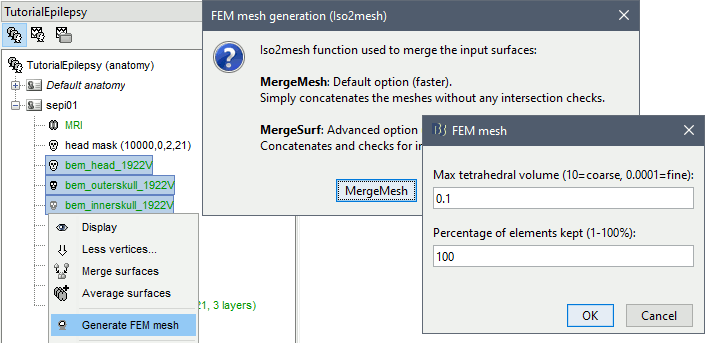
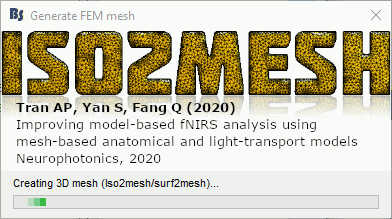
The FEM mesh appears in the database explorer after a short while. The first number indicates the number of vertices (i.e. nodes) of the tetrahedral mesh. To get the number of 3D elements (i.e. tetrahedrons) in this geometric model of the head: right-click on the file > File > View file contents. The structure of the file is describe in the tutorial FEM mesh generation.

Double-click on the FEM file to display it. From the Surface tab, you can change the resection locations by moving the bottom sliders, and you can control the display of each of the three layers individually. Click on the layer button in the toolbar, then adjust the color and transparency of the corresponding mesh. The figure below represents the FEM mesh in the center and the initial BEM layers on the right.
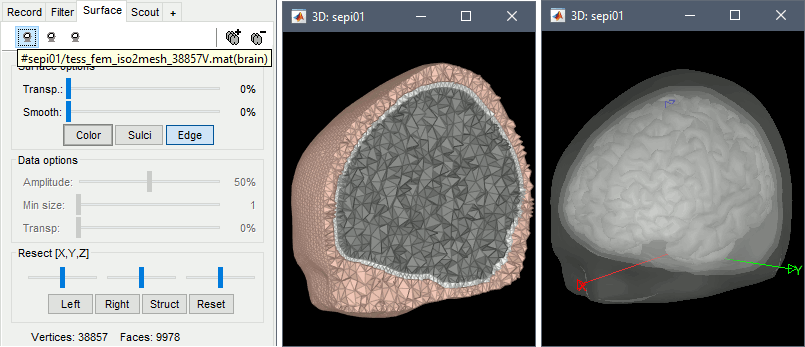
FEM forward model
The forward model (or head model in the Brainstorm documentation and interface) describes how the electric activity in the source space (the cortex surface or a regular grid of volume points) influences the electric potential (EEG) or magnetic fields (MEG) at the level of the sensors. The FEM method uses the tetrahedral mesh computed above to establish this relationship.
Go the Anatomy view. Select the default FEM mesh and cortex surface you'd like to use for the computation (in case there is more than one in each category). The selected elements appear in green, double-click or right-click > Set as default to change the selection.
Go to the Functional view. Right-click on the channel file > Compute head model.
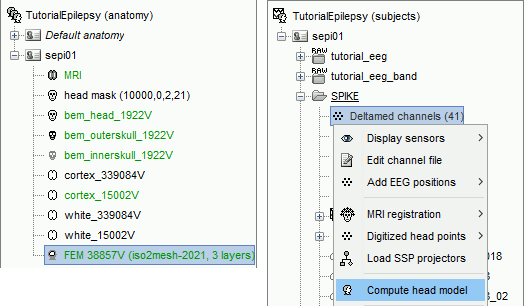
Select MRI volume, EEG: DUNEuro FEM, Regular grid: brain 5mm.
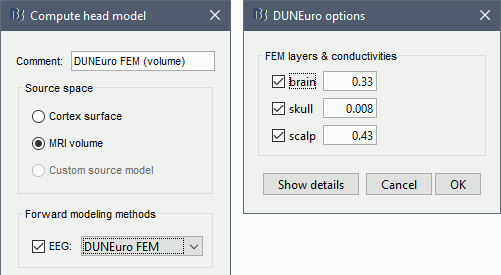
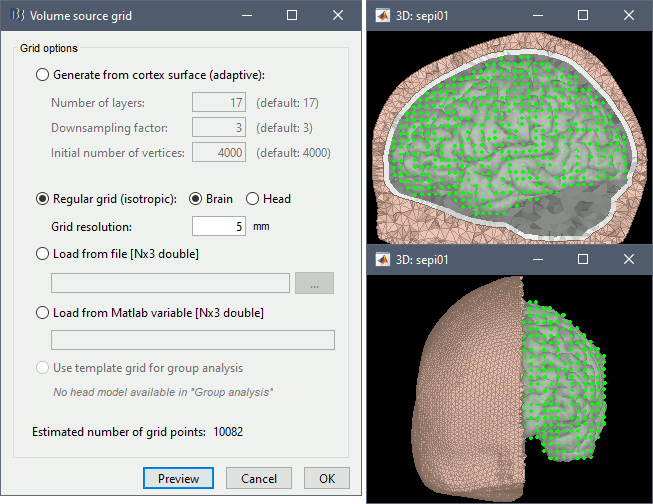
Start the computation. If you selected the correct files, it should only take a few minutes. You may be prompted to download or update the bst-duneuro plugin.
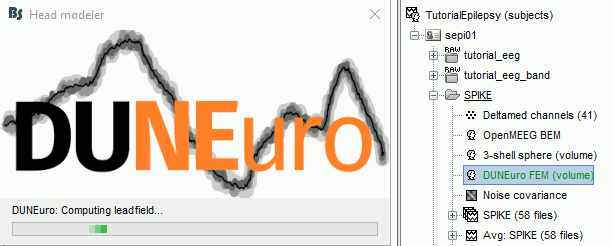
Basic DUNEuro options
When assuming isotropic conductivities for all the tissues, the DUNEuro basic options options are limited to the selection of the tissues and their conductivities.
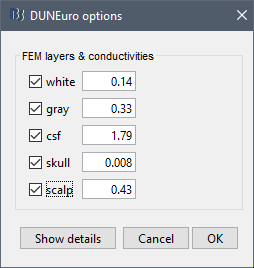
FEM tissues or layers: Brainstorm detects automatically the number of layers on your model. Users can select the desired layers to include for the FEM computation. According to the modalities, the recommended selections are:
- For EEG: select all the layers
- For MEG: use only select the inner layers (here brain)
- For SEEG: use only the inner layers
- For ECOG: use only the inner layers
- Any combinations that include MEG: use all the layers
FEM conductivities: Brainstorm detects automatically the number of layers and assigns the default isotropic value for each layer. However, you have the possibility to change these values according to your model.
For advanced users, check the advanced section and a more detailed example at this page FEM tensor.
Brainstorm will download the latest version of the bst-duneuro binaries for your operating system from the Github, and install it in Brainstorm user folder (~username/.brainstorm/bst-duneuro/). The calculation of the head model will start automatically. You may wait for a very long time, which depends on the mesh resolution, the number of sensors, and of course the capacity of your computer.
So, be patient, it's worth it... (for this model it's quite fast ... less than 10 min)
When it's finished, you have now a new head model for this subject in your database and can be used for the next steps/(back to tutorial 20 : Head modeling) ![]()
Anisotropy tensor from the DUNEuro options
In the case where the conductivity tensor are computed, Brainstorm detects and uses them for the FEM forward computation.
In this case, users can not change the conductivities values, since they are already computed as explained in this FEM tensor.
If at some points, for any reason, where users want to remove these FEM tensors, this can be done from the Brainstorm anatomy panel, select the FEM head model, right-click on the subject, and then "clear FEM tensor".
Advanced models and options
DUNEuro advanced options panel [to be completed]
From the previous panel, for advanced duneuro panel, click on the button "Show details", the following panel is displayed.
A set of advanced options are made available and can be easily changed. Here a short explanation is given for each option.
FEM layers & conductivities: same explanation as in the previous section. Moreover, in the case where the conductivity tensor are previously computed, Brainstorm detects these tensors and load them. In this case, the users can't change the conductivities scalar values, since they are not used. The following is displayed panel is displayed.
FEM solver type:
- CG or Continuous Galerkin: This is the standard Lagrangian method.
- DC or the Discontinuous Galerkin:
In this version, only the Fitted FEM approaches are integrated, that require the FEM mesh of the head model. Unfitted methods are also available within DUNEuro, and will be integrated soon in Brainstorm.
- FEM source model: The list of the available source are
- Venant
- Subtraction
- Partial Integration
For more information about these methods, users can check this thesis (Vorwek thesis).
- Source space
- Shrink source space: the location of dipoles are moved inward by the specified value in this field(in mm).
- Force source space: this is required in the case where the dipoles are not within the GM matter.
- Outputs options
- Save transfer matrix:
All these parameters are stored and passed to the DUNEuro as a text file. This file is the main interface that passes the parameters from Brainstorm to DUNEuro. More details about the integration can be found in these links:
GitHub repository for the Brainstorm-DUNEuro compilation and integration
GitHub repository for the matlab-duneuro interface
- Brainstorm-DUNEuro integration discussions:
FEM head model generation from MRI data
One of the advantages of the FEM is its ability to use more complex head models with realistic geometry. In this tutorial, we have shown a basic example, as an introduction.
For the generation of a more realistic head model, users can follow this FEM mesh tutorial to learn how to generate advanced FEM head models form magnetic resonance data.
FEM conductivity tensors generation from DWI data
Among the advantages of the FEM, the use of tissue anisotropy (conductivity). The estimation of the tissue anisotropy is performed with the Brainsuite diffusion pipeline (BDP). The diffusion tensor images (DTI) are estimated with Brainsuite from the diffusion-weighted images (DWI) and then converted to conductivity tensor using the effective medieum approach. In order to use this tool, you need to install Brainsuite software, the rest of the process is distributed within bst-duneuro.
For more information, users can follow this FEM tensor tutorial.
Troubleshooting
DUNEuro binaries may crash for various reasons: we tried to list the possible causes here. Many FEM forward modeling issues are related with memory overload or extremely long computation times. Reducing the size of the problem may help in many cases. If you cannot find a solution, please post the full error message on the Brainstorm user forum (you can copy-paste the error message from the Matlab command window after closing the error message box).
Grid error messages
- Error message: Coordinate is outside of the grid, or grid is not convex
- Explanation: Some dipoles are probably outside of the cortex, users need to correct the source space.
- Solution: ?
Remove the neck
One way to reduce the size of the forward problem is to decrease the number of FEM elements in the head model. When the field of the MRI is large, you may have the mesh of the neck and even the shoulders. In most cases, it is safe to remove the lower part of the FEM mesh, below the nose and the brainstem. Right-click on the FEM mesh > Resect Neck.
Once the process is finished, a new FEM mesh appears in the database, with a tag "resect". The following figure shows the model before (743828 vertices / 4079587 elements) and after resection (613955 vertices / 3400957 elements). It will reduce the size of the problem by 20%.
Additional documentation
Related tutorials
DUNEuro references
DUNEuro wiki: https://gitlab.dune-project.org/duneuro/duneuro/wikis/home
DUNEuro website: http://duneuro.org/
List of the parameters: https://docs.google.com/spreadsheets/d/1MqURQsszn8Qj3-XRX_Z8qFFnz6Yl2-uYALkV-8pJVaM/edit#gid=0
